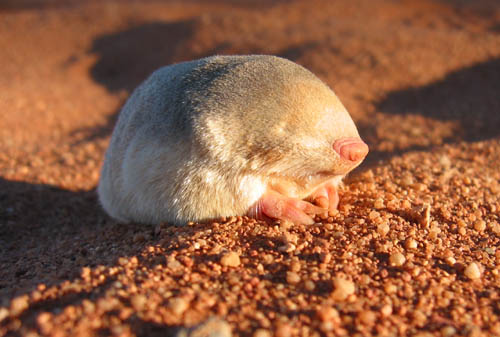Tuesday, February 21, 2012
Is iridescent fur wasted on the blind golden mole?
Despite human demand for fur coats, mammals are still the dowdiest members of the animal kingdom. While many birds, insects, and mollusks have iridescent coloration that gives off a metallic, shimmering appearance, mammals rely on pigments to imbue their fur with a single, matte color. Biologists think that iridescent animals use their flashy coloration to lure mates. However, a recent discovery of iridescent mammalian fur throws a wrench into the sexual display hypothesis. The iridescent coloration is possessed by a mammal that cannot even see – the blind golden mole.
The golden mole (Family: Chrysochloridae) is a burrowing animal that lives underground in sub-Saharan Africa. It has no need for sight, and its eyes are covered by skin and fur. Despite living in darkness, its dense coat shimmers with green, blue, and violet highlights. Dr. Matthew Shawkey of the University of Akron examined the microscopic, physical qualities of golden mole hairs and found that they are specially constructed to produce an iridescent sheen.
Whether it’s the rainbow shine of a soap bubble or a hummingbird’s shimmering throat feathers, iridescence occurs when light hitting different surfaces is reflected at different angles – a process known as thin-film interference. For these surfaces to shine though, their thickness must be just right. When Dr. Shawkey looked at a golden mole hair under an electron microscope, he found that its outer layer was composed of alternating layers of electron-dense and electron-lucent material. These layers happen to be the perfect thickness to reflect light at angles that produce iridescence through thin-film interference.
Other characteristics of the golden mole hair enhance the iridescent coloration. Instead of a continuous, tubular shape like most mammalian hairs, golden mole hairs become flat towards the ends. This flattened shape, also seen in iridescent bird feathers, provides more surface area for light reflection. Also, the golden mole hairs are smoother than typical mammalian hairs. Most mammalian hairs are covered by rough, cuticular scales that diffuse light. However, the cuticular scales of the iridescent golden mole hairs are compressed and smooth, which focuses more light on the reflective layers.
Like all mammals, the golden mole’s coat is actually composed of two hair types. The iridescent hairs are the protective, outer guard hairs. Golden moles also possess non-iridescent down hairs, which are dense, curly, and provide insulation for the animal. Dr. Shawkey observed that, in contrast to the iridescent guard hairs, the down hairs of the golden mole are thin and tubular with large cuticular scales. While they did not have the layered substructure of the iridescent hairs, their cells had many pigment organelles called melanosomes. The iridescent guard hairs on the other hand contained very few melanosomes.
While iridescence in mammalian fur is an amazing discovery, the reason behind such a trait, especially in a blind animal, remains unclear. Dr. Shawkey hypothesizes that the structure of the iridescent hairs is actually conducive to the mole’s underground lifestyle. Flattened guard hairs may help the moles move through the dirt. Also, the small, compressed cuticular scales likely reduce friction. It just so happens that these adaptations also give the golden mole guard hairs the perfect structure for iridescent coloration. For a mammal that never sees the light of day and couldn’t if it tried, the golden mole’s iridescent fur gives new meaning to ‘beauty is in the eye of the beholder.’
Holly K. Snyder, Rafael Maia, Liliana D'Alba, Allison J. Shultz, Karen M. C. Rowe, Kevin C. Rowe, and Matthew D. Shawkey. Iridescent colour production in hairs of blind golden moles (Chrysochloridae. Biol Lett 2012 : rsbl.2011.1168v1-rsbl20111168.
Photo: Namib Desert Golden Mole, Eremitalpa granti namibensis. By G. Rathbun, Afrotheria.net
Labels:
amazing adaptations,
extreme environments,
fur,
iridescence,
mammals
Subscribe to:
Post Comments (Atom)


No comments:
Post a Comment